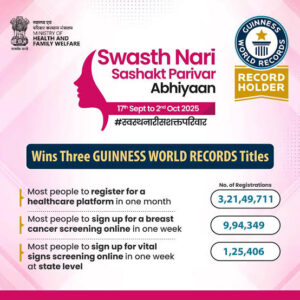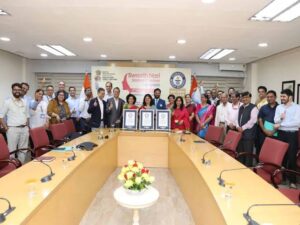Digital News Guru National Desk:
India Sets Three Guinness World Records Through Health Campaign
In a significant development for public health in India, the Swasth Nari, Sashakt Parivar Abhiyaan (SNSPA), a nationwide campaign spearheaded by the Ministry of Health and Family Welfare (MoHFW), has secured three new titles from the Guinness World Records (GWR).
Here’s a detailed breakdown of what happened and why it matters.
What were the records?
The records achieved under the SNSPA initiative are:
- The most people to register on a healthcare platform in one month: over 3.21 crore (32.1 million) registrations.
- The most people to sign up for online breast-cancer screening in one week: over 9.94 lakh (994,000).
- The most people to register for vital-signs screening online at the state level within one week: over 1.25 lakh (125,000) participants.

Launched by Narendra Modi on 17 September 2025 and run through 2 October or around that period (coinciding with “Poshan Maah”) the campaign focused on women’s health, adolescent girls, children and preventive care.
The campaign’s reach and scale are also remarkable: it covered every district in India, held 19.7 lakh (1.97 million) health camps and reported participation of over 11 crore (110 million) people across health platforms.
Why this is significant
- Scale and ambition – These records reflect an unprecedented mobilisation of people around preventive healthcare, especially empowering women and families.
- Digital health infrastructure – The huge registration numbers underscore how digital platforms are being leveraged for public health outreach in India.
- Women-centric & family health focus – With a campaign name translating roughly to “Healthy Woman, Empowered Family”, the emphasis shifts from disease treatment to prevention, nutrition, early screening, and holistic family health.
- Inter-sectoral coordination – More than 20 central ministries, medical colleges, private organisations, and community networks (self-help groups, school & college students, Panchayati Raj reps) took part, making it a “whole-of-government” and “whole-of-society” effort.
Key Stats & Outcomes
- Hypertension screenings: 1.78 crore (~17.8 million) people.
- Diabetes screenings: 1.73 crore (~17.3 million).
- Oral-cancer screenings: 69.5 lakh (6.95 million).
- Antenatal care check-ups: 62.6 lakh (6.26 million).
- Anaemia tests: 1.51 crore (15.1 million).
- Women screened for tuberculosis: 85.9 lakh (8.59 million).

These numbers highlight that the campaign wasn’t just about registrations or digital sign-ups, but also about real-world health screenings, check-ups and interventions.
What this means for India
- Prevention over cure: Shifting focus towards early detection and broader preventive health may help reduce the burden of non-communicable diseases and maternal/child health issues.
- Women as agents of health: By focusing on women (the “nari” in the campaign), the idea is that healthier women lead to healthier families—thus leveraging a multiplier effect.
- Digital + physical integration: The large numbers show that digital registrations and online screenings combined with physical health camps can reach large populations.
- Potential for policy momentum: With such visible success, there is scope for sustained investment in screening, nutrition, community health, digital health platforms, and rural outreach.
Challenges to watch
- Sustainability: Achieving records and high participation is one thing—but ensuring continued follow-up, treatment, and behaviour change is another.
- Quality vs quantity: Large numbers are impressive but monitoring whether screenings lead to actual improved outcomes (e.g., diagnoses followed by treatment) is crucial.
- Equity: Ensuring that the most vulnerable and remote communities benefit equally (and not just urban or easily-accessible populations) will be important.
- Resource demands: Massive camps and screenings require logistics, staffing, supplies, follow-up care—can the system sustain this beyond the campaign period?

The Road Ahead
For the initiative to translate into lasting impact, the following will be critical:
- Mapping the participants who registered and focusing on those who need further care.
- Strengthening local health infrastructure so screenings translate to timely treatment.
- Sustaining community engagement and awareness beyond the campaign window.
- Leveraging data from the campaign to plan targeted interventions (for example, high-risk districts or population segments).
- Ensuring digital platforms and health camps are not one-time events but part of an ongoing continuum of care.
In short, India’s achievement of three Guinness World Records under the Swasth Nari, Sashakt Parivar campaign is a milestone—not just for the numbers, but for what it symbolizes: a large-scale, coordinated push for preventive health, women’s empowerment, and community participation. The real test now will be converting this momentum into improved health outcomes and sustainable systems.
You May Also Read: Kartik Aaryan has officially begun shooting for his upcoming film Naagzilla








